UNet-Based Framework for Predicting the Waveform of Laser Pulses of the Front-End System in a Current High-Power Laser Facility
Abstract
1. Introduction
- rUNet: We propose an innovative architecture of UNet of a series residual module to predict the temporal shape of laser pulses according to the chained features of the front-end laser system.
- Missing values are filled in in the database of measuring pulse waveform in a current high-power laser facility from the perspective of analyzing and summarizing historical data of pulse waveform for the first time.
- The strategy of relay output and relay loss is employed in training in order to enable the model to predict two kinds of pulse waveforms simultaneously.
2. Current Status of Waveform Database and rUNet for Predicting Pulse Waveform
2.1. Current Status of Waveform Database of the Current High-Power Laser Facility
2.2. rUnet for Predicting Pulse Waveform of the Front-End Laser System
3. Methodology
3.1. Overall Architecture
3.2. Data Collection and Preprocessing
3.3. Implementation and Training
4. Results
4.1. Testing Results
4.2. Comparison Results
4.3. Discussion
5. Conclusions
Author Contributions
Funding
Institutional Review Board Statement
Informed Consent Statement
Data Availability Statement
Conflicts of Interest
References
- Perry, T.S.; Wilde, B.H. NIF system-design requirements for nuclear-weapons physics experiments. Off. Sci. Tech. Inf. Tech. Rep. 1995. [Google Scholar] [CrossRef][Green Version]
- Le Garrec, B.; Nicolas, O. Laser performance operation model and its application to LIL energy and power balance. J. Phys. Conf. Ser. 2008, 112, 032019. [Google Scholar] [CrossRef]
- Zacharias, R.A.; Beer, N.R.; Bliss, E.S.; Burkhart, S.C.; Cohen, S.J.; Sutton, S.B.; Van Atta, R.L.; Winters, S.E.; Salmon, J.T.; Stolz, C.J. National Ignition Facility alignment and wavefront control. In Proceedings of the Optical Engineering at the Lawrence Livermore National Laboratory II: The National Ignition Facility, San Jose, CA, USA, 28 May 2004; pp. 168–179. [Google Scholar]
- Zacharias, R.A.; Beer, N.R.; Bliss, E.S.; Burkhart, S.C.; Cohen, S.J.; Sutton, S.B.; Van Atta, R.; Winters, S.E.; Salmon, J.T.; Latta, M.R. Alignment and wavefront control systems of the National Ignition Facility. Opt. Eng. 2004, 43, 2873–2884. [Google Scholar] [CrossRef]
- Shaw, M.; House, R. Laser performance operations model (LPOM): The computational system that automates the setup and performance analysis of the National Ignition Facility. In Proceedings of the High Power Lasers for Fusion Research III, San Francisco, CA, USA, 26 February 2015; pp. 91–106. [Google Scholar]
- Shaw, M.; Williams, W.; House, R.; Haynam, C. Laser performance operations model. Opt. Eng. 2004, 43, 2885–2895. [Google Scholar] [CrossRef]
- Shaw, M.J.; Williams, W.H.; Jancaitis, K.S.; Widmayer, C.C.; House, R. Preformance and operational modeling of the National Ignition Facility. In Proceedings of the Optical Modeling and Performance Predictions, San Diego, CA, USA, 22 January 2004; pp. 194–203. [Google Scholar]
- Sacks, R.; Henesian, M.; Haney, S.; Trenholme, J. The PROP92 Fourier beam propagation code. Foreword iii WARP3d, a Three-Dimensional PIC Code for High-Current 129 Ion-Beam Propagation Developed for Heavy-Ion Fusion. Foreword Iii WARP3d A Three-Dimens. PIC Code High-Curr. 129 Ion-Beam Propag. Dev. Heavy-Ion Fusion 1996, CRL-LR-105821-96, 207–216. [Google Scholar]
- Humbird, K.D.; Peterson, J.L.; McClarren, R.G. Predicting the time-evolution of multi-physics systems with sequence-to-sequence models. arXiv 2018, arXiv:1811.05852. [Google Scholar]
- Kustowski, B.; Gaffney, J.A.; Spears, B.K.; Anderson, G.J.; Thiagarajan, J.J.; Anirudh, R. Transfer learning as a tool for reducing simulation bias: Application to inertial confinement fusion. IEEE Trans. Plasma Sci. 2019, 48, 46–53. [Google Scholar] [CrossRef]
- Anirudh, R.; Thiagarajan, J.J.; Bremer, P.-T.; Spears, B.K. Improved surrogates in inertial confinement fusion with manifold and cycle consistencies. Proc. Natl. Acad. Sci. USA 2020, 117, 9741–9746. [Google Scholar] [CrossRef] [PubMed]
- Denis, V.; Nicolaizeau, M.; Néauport, J.; Lacombe, C.; Fourtillan, P. LMJ 2021 facility status. In Proceedings of the High Power Lasers for Fusion Research VI, Online, 6 May 2021; pp. 5–14. [Google Scholar]
- Zou, L.; Geng, Y.; Liu, B.; Chen, F.; Zhou, W.; Peng, Z.; Hu, D.; Yuan, Q.; Liu, G.; Liu, L. CNN-based neural network model for amplified laser pulse temporal shape prediction with dynamic requirement in high-power laser facility. Opt. Express 2022, 30, 29885–29899. [Google Scholar] [CrossRef] [PubMed]
- Luo, J.; Tian, Z.; Li, L.; Ni, Z.; Xie, X.; Zhou, X. Embedding AI into laser pulse shaping closed-loop control. Fusion Eng. Des. 2023, 194, 113888. [Google Scholar] [CrossRef]
- Hu, D.; Dong, J.; Xu, D.; Huang, X.; Zhou, W.; Tian, X.; Zhou, D.; Guo, H.; Zhong, W.; Deng, X. Generation and measurement of complex laser pulse shapes in the SG-III laser facility. Chin. Opt. Lett. 2015, 13, 041406. [Google Scholar]
- Ronneberger, O.; Fischer, P.; Brox, T. U-net: Convolutional networks for biomedical image segmentation. In Proceedings of the Medical Image Computing and Computer-Assisted Intervention–MICCAI 2015: 18th International Conference, Munich, Germany, 5–9 October 2015; Proceedings, Part III 18. pp. 234–241. [Google Scholar]
- Stoller, D.; Tian, M.; Ewert, S.; Dixon, S. Seq-u-net: A one-dimensional causal u-net for efficient sequence modelling. arXiv 2019, arXiv:1911.06393. [Google Scholar]
- Acock, A.C. Working with missing values. J. Marriage Fam. 2005, 67, 1012–1028. [Google Scholar] [CrossRef]
- He, K.; Zhang, X.; Ren, S.; Sun, J. Deep residual learning for image recognition. In Proceedings of the IEEE Conference on Computer Vision and Pattern Recognition, Las Vegas, NV, USA, 26 June–1 July 2016; pp. 770–778. [Google Scholar]
- Kingma, D.P.; Ba, J. Adam: A method for stochastic optimization. arXiv 2014, arXiv:1412.6980. [Google Scholar]
- Spaeth, M.L.; Manes, K.R.; Bowers, M.; Celliers, P.; Nicola, J.-M.D.; Nicola, P.D.; Dixit, S.; Erbert, G.; Heebner, J.; Kalantar, D. National ignition facility laser system performance. Fusion Sci. Technol. 2016, 69, 366–394. [Google Scholar] [CrossRef]
- Osthus, D.; Vander Wiel, S.A.; Hoffman, N.M.; Wysocki, F.J. Prediction uncertainties beyond the range of experience: A case study in inertial confinement fusion implosion experiments. SIAM/ASA J. Uncertain. Quantif. 2019, 7, 604–633. [Google Scholar] [CrossRef]


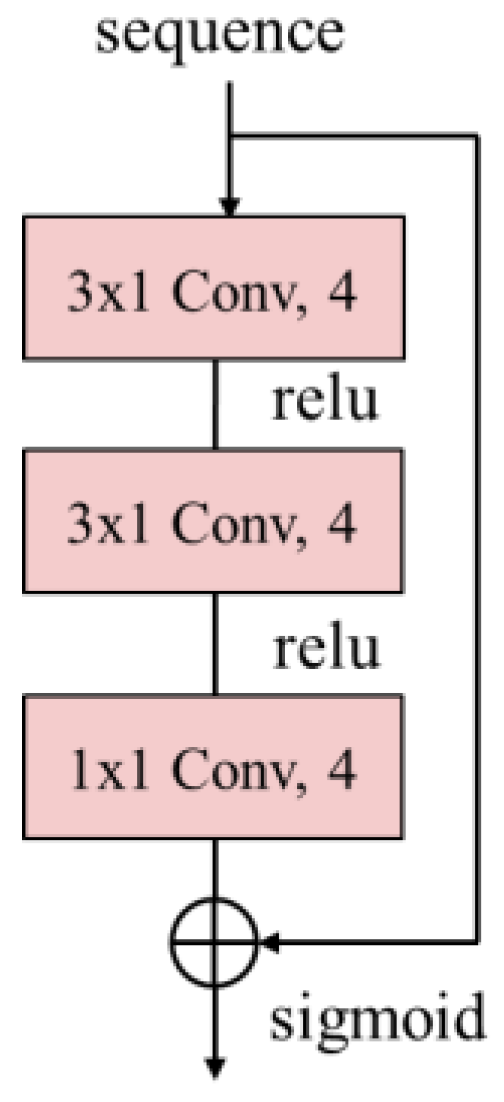
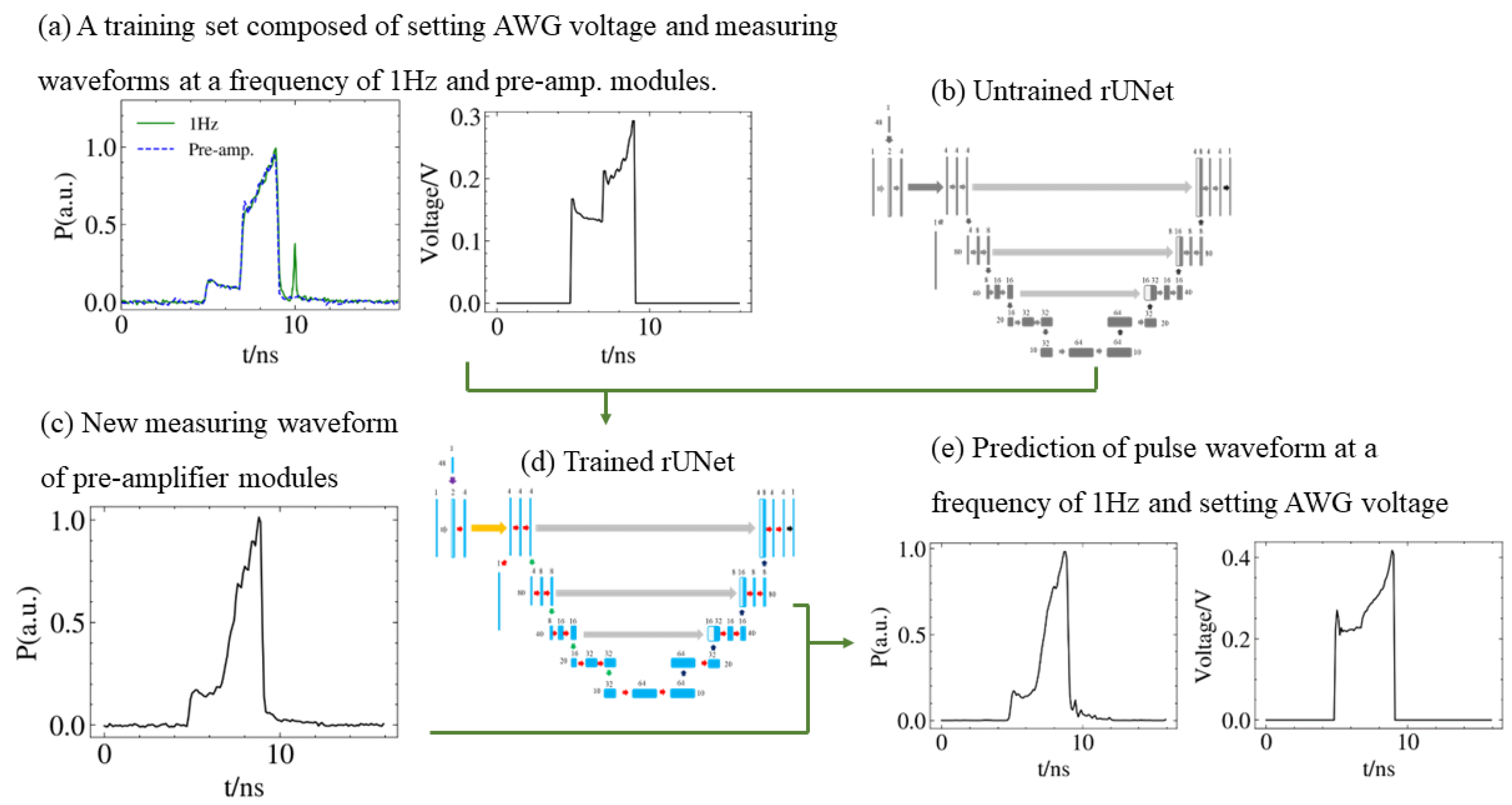
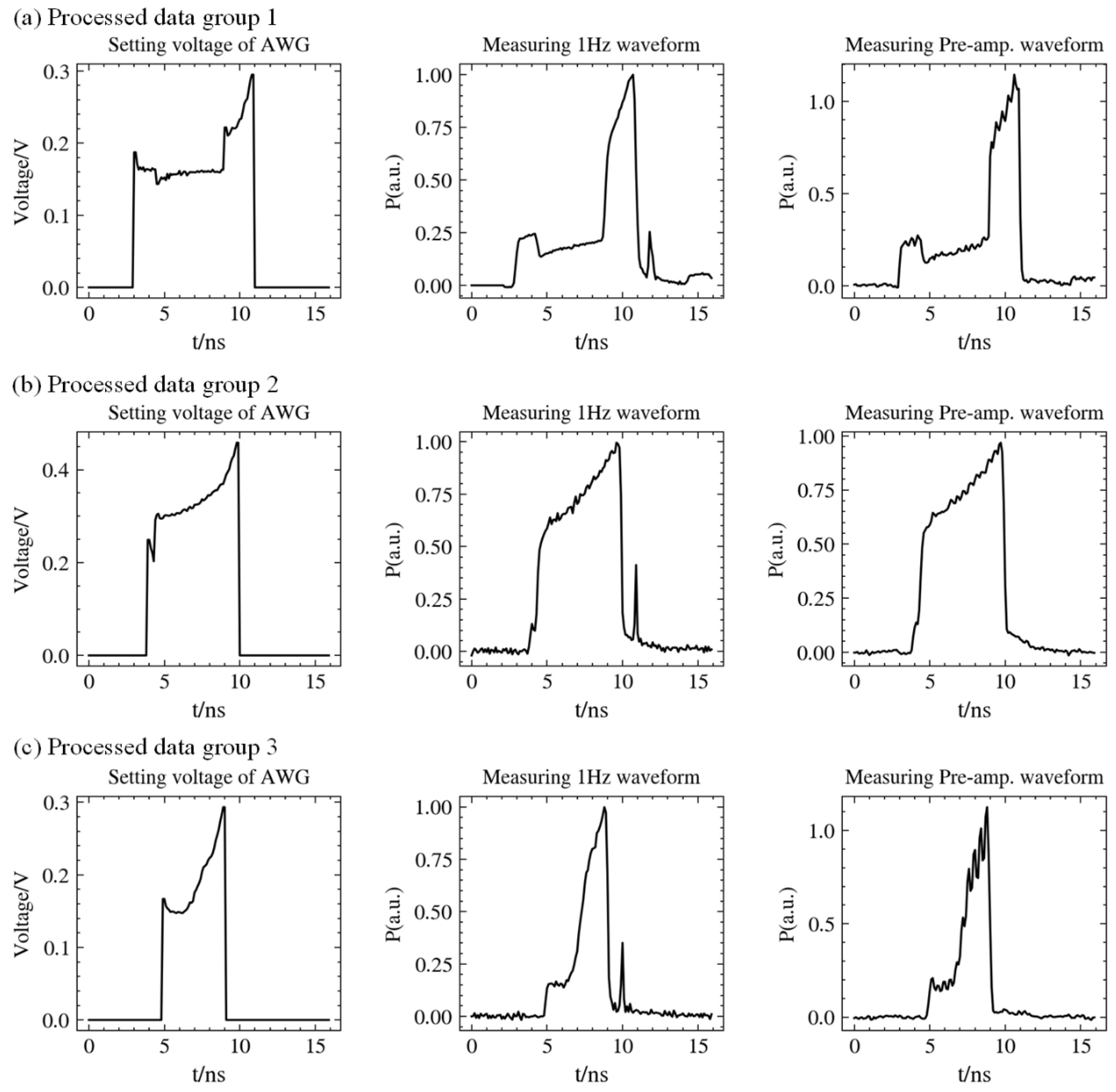
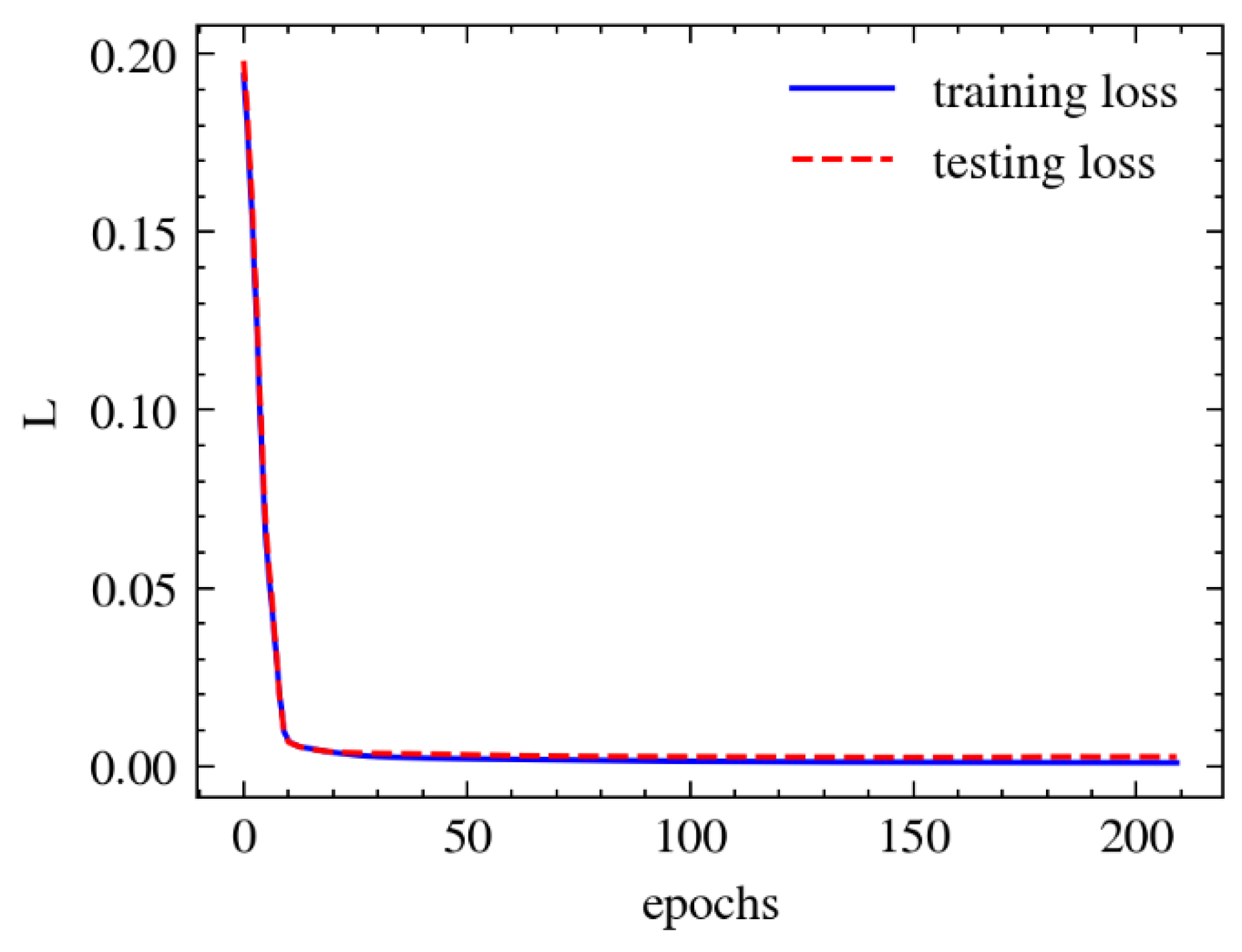
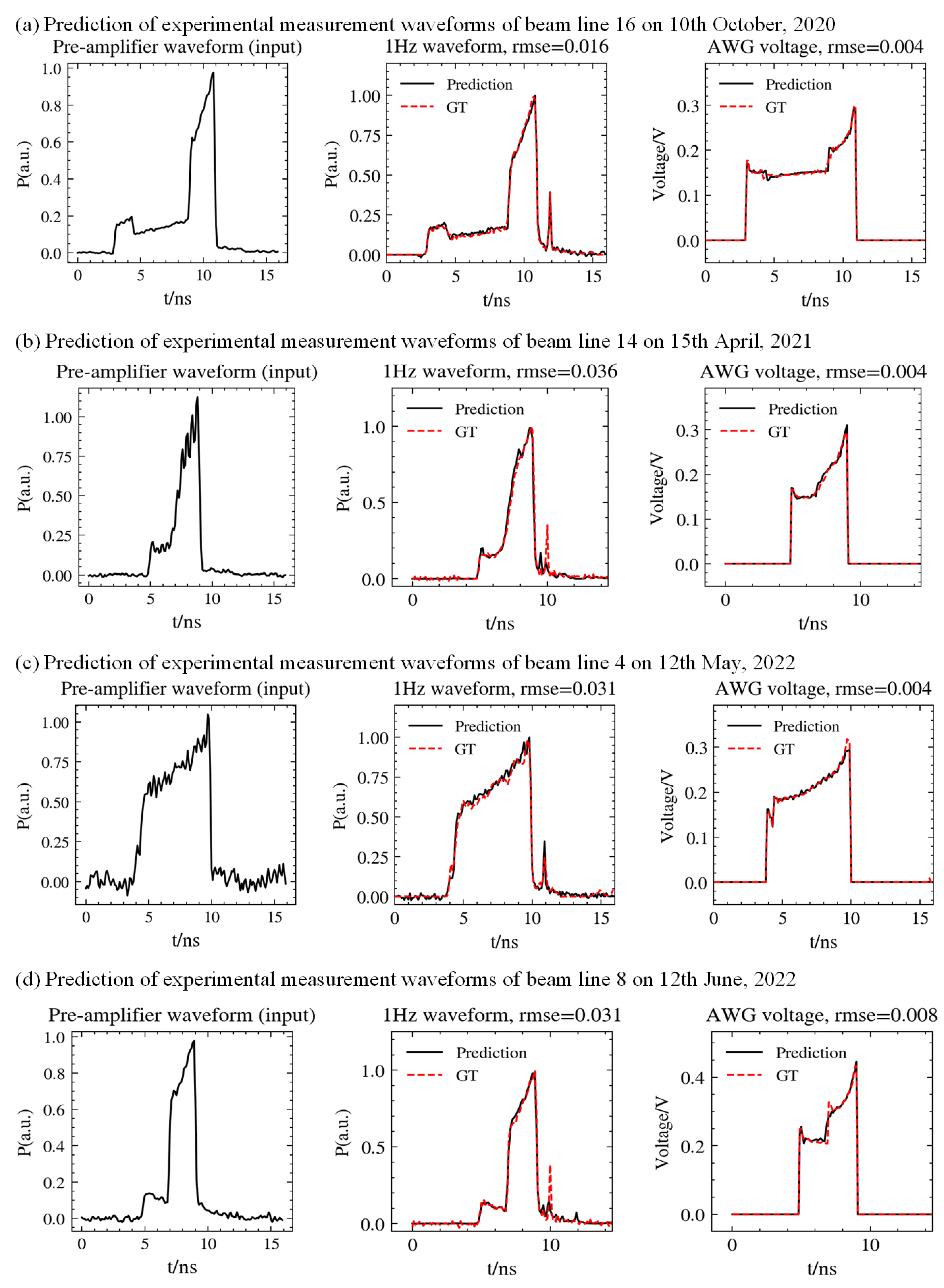
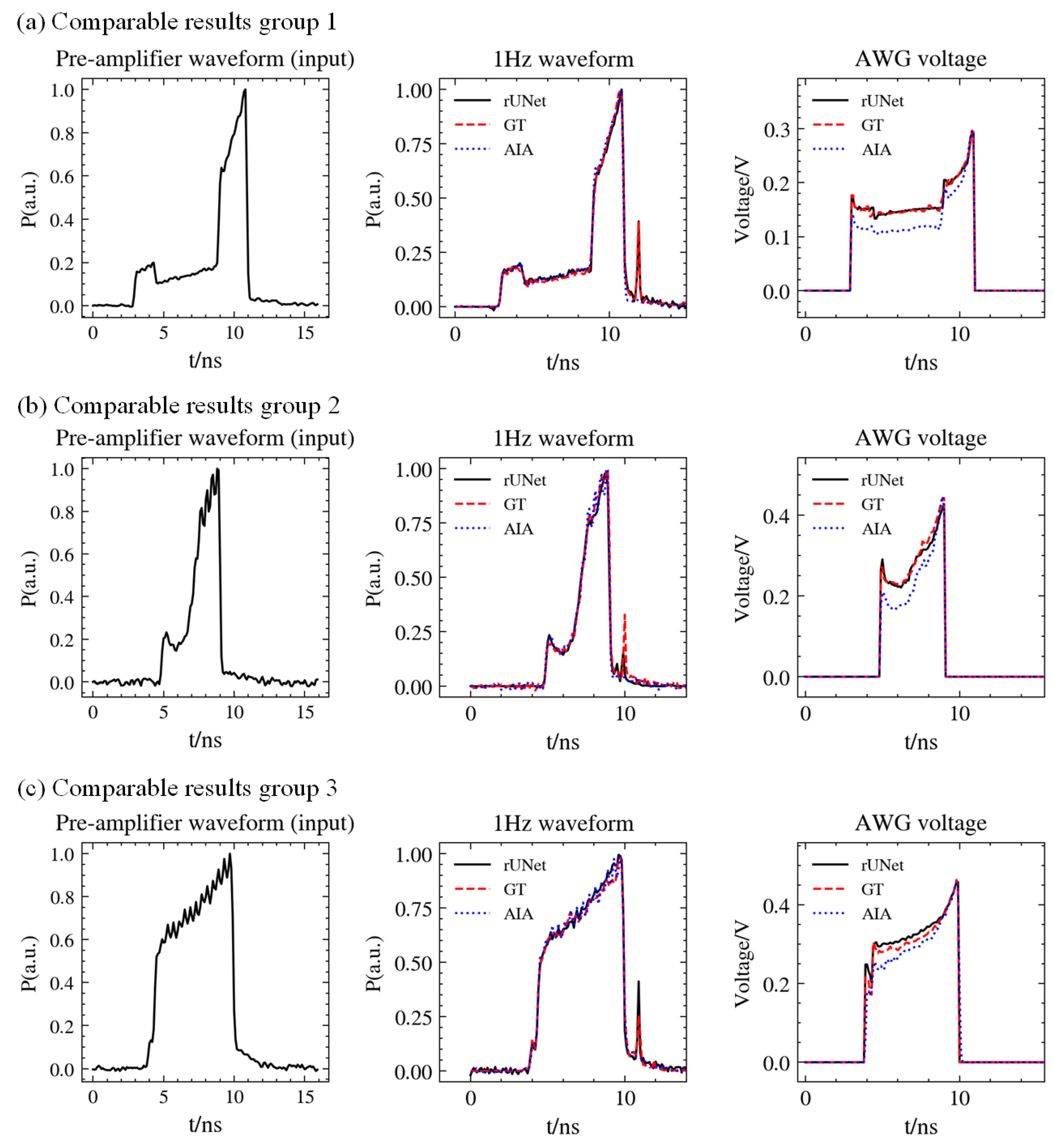
| The Number of Beam Line | Setting Voltage of AWG | Pulse Waveform at a Frequency of 1 Hz | Pre-Amplifier Modules | Main Amplifier | Target Chamber |
|---|---|---|---|---|---|
| 1 | 1 | 1 | 1 | 1 | 1 |
| 2 | 1 | 1 | 1 | 1 | 1 |
| 3 | 1 | 1 | 1 | 1 | 1 |
| 4 | 1 | 1 | 1 | 1 | 1 |
| 5 | 1 | 1 | 1 | 1 | 1 |
| 6 | 0 | 0 | 1 | 1 | 1 |
| 7 | 1 | 1 | 1 | 1 | 1 |
| 8 | 1 | 1 | 1 | 1 | 1 |
| 9 | 1 | 1 | 1 | 1 | 1 |
| 10 | 0 | 0 | 1 | 1 | 1 |
| 11 | 0 | 0 | 1 | 1 | 1 |
| 12 | 0 | 0 | 1 | 1 | 1 |
| 13 | 1 | 1 | 1 | 1 | 1 |
| 14 | 0 | 0 | 1 | 1 | 1 |
| 15 | 0 | 0 | 1 | 1 | 1 |
| 16 | 0 | 0 | 1 | 1 | 1 |
| Methods | RMSE of 1 Hz Waveform/% | RMSE of AWG Voltage/% |
|---|---|---|
| AIA | 3.69 | 1.74 |
| rUNet | 3.38 | 0.84 |
Disclaimer/Publisher’s Note: The statements, opinions and data contained in all publications are solely those of the individual author(s) and contributor(s) and not of MDPI and/or the editor(s). MDPI and/or the editor(s) disclaim responsibility for any injury to people or property resulting from any ideas, methods, instructions or products referred to in the content. |
© 2023 by the authors. Licensee MDPI, Basel, Switzerland. This article is an open access article distributed under the terms and conditions of the Creative Commons Attribution (CC BY) license (https://creativecommons.org/licenses/by/4.0/).
Share and Cite
Liao, Y.; Huang, X.; Geng, Y.; Yuan, Q.; Hu, D. UNet-Based Framework for Predicting the Waveform of Laser Pulses of the Front-End System in a Current High-Power Laser Facility. Photonics 2023, 10, 1244. https://doi.org/10.3390/photonics10111244
Liao Y, Huang X, Geng Y, Yuan Q, Hu D. UNet-Based Framework for Predicting the Waveform of Laser Pulses of the Front-End System in a Current High-Power Laser Facility. Photonics. 2023; 10(11):1244. https://doi.org/10.3390/photonics10111244
Chicago/Turabian StyleLiao, Yuzhen, Xiaoxia Huang, Yuanchao Geng, Qiang Yuan, and Dongxia Hu. 2023. "UNet-Based Framework for Predicting the Waveform of Laser Pulses of the Front-End System in a Current High-Power Laser Facility" Photonics 10, no. 11: 1244. https://doi.org/10.3390/photonics10111244
APA StyleLiao, Y., Huang, X., Geng, Y., Yuan, Q., & Hu, D. (2023). UNet-Based Framework for Predicting the Waveform of Laser Pulses of the Front-End System in a Current High-Power Laser Facility. Photonics, 10(11), 1244. https://doi.org/10.3390/photonics10111244




